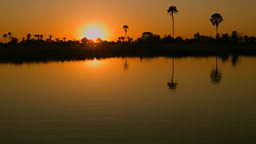The Okavango Delta explained...
by Paul Bradshaw, Series Producer
It rains even in the Kalahari and the Okavango Delta, helping to sustain life.
The Okavango Delta lies at the heart of one of the world’s largest deserts, the Kalahari. As summer comes to southern Africa, the band of humid air, known as the Intertropical Convergence Zone (ITCZ) moves south, bringing rain. It rains even in the Kalahari and the Okavango Delta, helping to sustain life. But the really big change comes as a result of rains over a thousand kilometres to the north, in the highlands of Angola. Vast amounts of this rainwater flow into the tributaries of the Okavango river, which slowly snakes south, across the flat Kalahari, eventually ending at the sprawling Okavango Delta and turning a large area of Savannah into a beautiful palm-fringed waterworld – right in the middle of the dry season.
The Okavango Delta has been a mystery to us humans for some time. Locals told the incredulous Scottish missionary and explorer, David Livingstone, of a ‘Country full of rivers, so many, no one can tell their number’, and that the rivers ran not into the ocean but into the sand! Hard as these things were to believe, they were and are perfectly true.
In recent years, science has shone a light on how this delta came into being and how it works. Around two million years ago, as Africa’s Great Rift Valley formed, splitting the Earth’s crust across the region, it cut off the Okavango river from reaching a great lake to the south and created what amounts to a massive puddle between the fault lines – the Okavango Delta!
But this isn’t the whole story. Incredibly, the Delta owes as much for its existence, to the animals that live here, as it does to geology.






